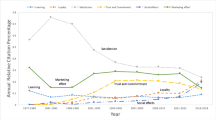Abstract
Experience weighted attraction (EWA) combines reinforcement learning with fictious play models and has proven to perform well as an explanatory model in economic experiments on individual decision making. Yet, EWA is a relatively complex model with a rather large number of free parameters and includes characteristics of simpler decision models, which might explain its good performance on laboratory data in the past. We present a simulation study which uses different models (including EWA) to generate order decisions in a newsvendor setting. Next, maximum likelihood estimations of these models are executed on the generated data and the fit of the models is evaluated using information criteria. Attention is focused on the performance of EWA. Furthermore, we present analyses on the parameter mix of EWA if more parsimonious models or a mix of these simpler models are used. Our results indicate that decision makers in newsvendor problems do not follow unique and simple decision rules. The results indicate that (1) the maximum likelihood procedure combined with the use of information criteria generally is suited to identify the true model; (2) EWA does not perform well when static models are given; yet, (3) in a mix of static and dynamic models EWA once again performs best. Given the past success of EWA on experimental data on both aggregate and individual level, these results may indicate that decision makers in newsvendor problems do not follow unique and simple decision rules.
Similar content being viewed by others
Notes
The following discussions are partly included in Köster and Schenk-Mathes (2016).
N.B., that for easier readability most formulas in this paper, like the one below for the expected profit, treat demand as being continuous. We used discrete demand in the actual coding of the simulation.
References
Akaike H (1973) Information theory and an extension of the maximum likelihood principle. In: Petrov BN, Caski F (eds) Proceedings of the second international symposium on information theory. Budapest, pp 267–281
Benzion U, Cohen Y, Peled R, Shavit P (2008) Decision-making and the newsvendor problem—an experimental study. J Oper Res Soc 59:1281–1287. https://doi.org/10.1057/palgrave.jors.2602470
Bolton GE, Ockenfels A, Thonemann U (2012) Managers and students as newsvendors. Manag Sci 58:2225–2233. https://doi.org/10.1287/mnsc.1120.1550
Bostian AA, Holt CA, Smith AM (2008) Newsvendor “Pull-to-Center” effect: adaptive learning in a laboratory experiment. Manuf Serv Oper Manag 10:590–608. https://doi.org/10.1287/msom.1080.0228
Camerer CF, Ho TH (1998) Experience-weighted attraction learning in coordination games: probability rules, heterogeneity, and time-variation. J Math Psychol 42:305–326. https://doi.org/10.1006/jmps.1998.1217
Croson D, Croson R, Ren Y (2008) How to manage an overconfident newsvendor. Working Paper, Southern Methodist University
Cui Y, Chen LG, Chen J, Gavirneni S, Wang Q (2013) Chinese perspective on newsvendor bias: an exploratory note. J Oper Manag 31:93–97. https://doi.org/10.1016/j.jom.2012.10.001
de Véricourt F, Jain K, Bearden JN, Filipowicz A (2013) Sex, risk and the newsvendor. J Oper Manag 31:86–92. https://doi.org/10.1016/j.jom.2012.11.001
Dertwinkel-Kalt M, Köster M (2017) Salient compromises in the newsvendor game. J Econ Behav Organ 141:301–315. https://doi.org/10.1016/j.jebo.2017.07.008
Feng T, Keller LR, Zheng X (2011) Decision making in the newsvendor problem: a cross-national laboratory study. Omega 39:41–50. https://doi.org/10.1016/j.omega.2010.02.003
Ho T-H, Camerer CF, Chong J-K (2007) Self-tuning experience weighted attraction learning in games. J Econ Theory 133:177–198. https://doi.org/10.1016/j.jet.2005.12.008
Ho T-H, Lim N, Cui TH (2010) Reference dependence in multilocation newsvendor models. A structural analysis. Manag Sci 56:1891–1910. https://doi.org/10.1287/mnsc.1100.1225
Köster C (2015) Bestellmengenentscheidungen bei asymmetrisch verteilter Nachfrage. Springer, Wiesbaden
Köster C, Schenk-Mathes HY (2016) Explanatory and predictive power of the adaptive learning model. Average and heterogeneous behavior in a newsvendor context. J Bus Econ 86:361–387. https://doi.org/10.1007/s11573-016-0814-8
Kuha J (2004) AIC and BIC: comparison of assumptions and performance. Sociol Methods Res 33:188–229. https://doi.org/10.1177/0049124103262065
Long X, Nasiry J (2014) Prospect theory explains newsvendor behavior. the role of reference points. Manag Sci 61:3009–3012. https://doi.org/10.1287/mnsc.2014.2050
Luce RD (1959) Individual choice behavior: a theoretical analysis. Wiley, New York
McFadden DL (1976) Quantal choice analaysis: a survey. Ann Econ Soc Meas 5:363–390
Nagarajan M, Shechter S (2014) Prospect theory and the newsvendor problem. Manag Sci 60:1057–1062. https://doi.org/10.1287/mnsc.2013.1804
Ockenfels A, Selten R (2014) Impulse balance in the newsvendor game. Games Econ Behav 86:237–247. https://doi.org/10.1016/j.geb.2014.03.012
Ren Y, Croson R (2013) Overconfidence in newsvendors orders: an experimental study. Manag Sci 59:2502–2517. https://doi.org/10.1287/mnsc.2013.1715
Schwarz G (1978) Estimating the dimension of a model. Ann Stat 6:461–464
Schweitzer ME, Cachon GP (2000) Decision bias in the newsvendor problem with a known demand distribution: experimental evidence. Manag Sci 46:404–420. https://doi.org/10.1287/mnsc.46.3.404.12070
Su X (2008) Bounded rationality in newsvendor models. Manuf Serv Oper Manag 10:566–589. https://doi.org/10.1287/msom.1070.0200
Author information
Authors and Affiliations
Corresponding author
Rights and permissions
About this article
Cite this article
Köster, C., Schenk-Mathes, H. & Specht, C. Explanatory power of behavioral models in the newsvendor problem: a simulation study. Cent Eur J Oper Res 27, 311–324 (2019). https://doi.org/10.1007/s10100-018-0589-9
Published:
Issue Date:
DOI: https://doi.org/10.1007/s10100-018-0589-9
Keywords
- Adaptive learning
- Simulation
- Individual decision making
- Behavioral operations management
- Newsvendor problem




